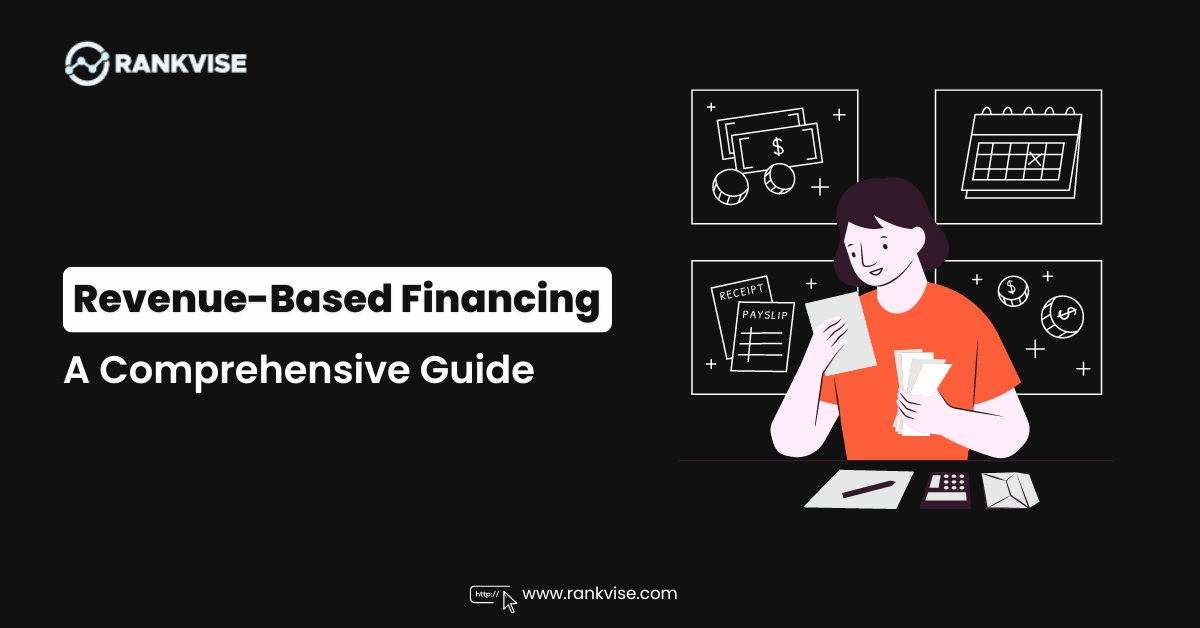Running a business is exhilarating. You have a vision, the drive, and maybe even a killer product. But what if you need a little extra sunshine to help it flourish? Traditional funding options can feel restrictive. Banks demand collateral you might not have, and giving up equity dilutes your control. Enter Revenue-Based Financing (RBF), a unique funding model that breaks the mold.
In this post, we’ll delve into the world of RBF, explaining how it works and why it’s become a breath of fresh air for companies like yours. So, buckle up and get ready to explore a financing option that thrives alongside your business!
Explain with Simple Example
Revenue-Based Financing is like a loan for growing businesses. Instead of fixed payments, you repay a percentage of your sales, so you only pay more when you earn more. This lets you access capital without giving up equity in your company.
Imagine a business as a fruit tree. It’s young, full of potential, but hasn’t quite blossomed yet. Revenue-Based Financing (RBF) is like sunshine and rain for this little tree.
Here’s the twist: an investor shows up, not asking for a piece of the fruit (equity), but for a share of the future harvest (revenue). They provide the nourishment (capital) to help the tree flourish.
The more fruit the tree bears (higher revenue), the bigger the basket the investor fills (larger revenue share). But if the tree struggles (low revenue), the investor feels the pinch too (smaller revenue share).
It’s a partnership where both sides are aligned for growth. The investor gets rewarded for their belief in the potential, and the business owner retains full control without giving away a piece of the tree (equity dilution).
This approach is particularly sweet for businesses that are hesitant to share ownership or can’t access traditional loans. It’s a unique way to fuel growth, with investor success blossoming alongside the business.
How Revenue-Based Financing Works
In simpler terms, imagine Revenue-Based Financing as a loan that adjusts to your business’s performance. You get the capital you need upfront, and you repay the investor a percentage of your sales instead of fixed monthly payments.
This way, you only pay more when you make more money, and there’s no pressure to come up with repayments during slow periods. Additionally, unlike traditional loans, RBF doesn’t require you to give up equity in your company. This means you retain full control over your business decisions.
| Step | Description |
|---|---|
| 1. Raise Capital | You secure funding from an investor through RBF. |
| 2. Revenue Sharing | You agree to repay the investment plus a percentage of your future sales. The percentage is fixed and predetermined in the agreement. |
| 3. Performance-Based Repayment | You only make repayments when you generate sales. If sales are low, your repayment amounts are lower. <br> If sales are high, you repay more quickly. |
| 4. Maintain Control | Unlike traditional equity financing, you don’t give up ownership of your company. |
Revenue-Based Financing vs. Other Startup Financing Sources
Startups that don’t qualify for bank or venture capital investment may choose revenue-based financing. It allows companies to raise large sums of money without giving up stock and may be designed to pay based on real income rather than expectations.
Startups may have additional funding choices. Some firms use small business loans South Carolina to borrow against future sales on flexible terms. Many entrepreneurs choose venture debt and debt funding with lengthier payback durations than revenue-based investment.
The Contenders:
- Revenue-Based Financing (RBF): Get capital upfront in exchange for a share of future sales.
- Bootstrapping: Fund your business yourself using personal savings or revenue.
- Debt Financing (Bank Loans): Borrow money from a bank and repay with interest at a fixed rate.
- Venture Capital (VC): Investors provide capital in exchange for equity (ownership stake) in your company.
| Feature | Revenue-Based Financing | Bootstrapping | Debt Financing | Venture Capital |
|---|---|---|---|---|
| Control | High: You retain full ownership. | Highest: You answer to no one but yourself. | Medium: Banks may have collateral requirements. | Low: VCs have significant influence on decisions. |
| Repayment | Variable: Repayments based on a % of sales. | Variable: Use profits to reinvest or repay debts. | Fixed: Consistent monthly payments regardless of sales. | Variable: Exit strategy (IPO, acquisition) expected. |
| Speed | Faster: RBF can be quicker than VC funding. | Variable: Depends on your savings and revenue. | Variable: Loan approval times can vary. | Slower: VC due diligence takes time. |
| Ideal for | Early-stage businesses with predictable revenue streams. | Resourceful founders with initial capital or low burn rate. | Established businesses with good credit history. | High-growth companies with significant upside potential. |
Revenue-based financing lets entrepreneurs get rapid money without giving up ownership. It offers cheap interest rates and flexible payback periods to companies borrowing against future income. Before investing, investors should understand the dangers and compare it to other options. Many sorts of organizations may benefit from revenue-based financing with proper thought and due research.
Types of Companies is Eligible For Revenue-Based Funding
Revenue-Based Financing (RBF) isn’t a perfect fit for every company, but it caters well to specific business types with some key characteristics. Here’s who tends to thrive with RBF:
1. Businesses with Predictable & Recurring Revenue:
SaaS (Software-as-a-Service) Companies: Subscription-based software models offer predictable revenue streams, making it easier for investors to assess risk and determine repayment terms.
eCommerce Businesses with Recurring Customers: Companies with a strong customer base that makes repeat purchases or subscribes to services are ideal candidates.
2. Businesses with High Gross Margins:
High gross margins (revenue minus cost of goods sold) signify a company’s ability to generate profit after accounting for production costs. This ensures they have enough leftover income to comfortably make RBF repayments.
3. Businesses with Established Product-Market Fit:
RBF funders typically prefer businesses that have already validated their product or service in the market. This reduces the risk of the company struggling to generate sales and fulfill repayment obligations.
4. Early-Stage to Mid-Stage Companies:
While some later-stage companies might utilize RBF, it’s most commonly used by businesses that are past the initial startup phase and demonstrate traction but still need capital for growth initiatives like marketing or product development.
Beyond these core categories, other businesses can potentially benefit from RBF depending on their specific circumstances. It’s always wise to discuss your situation with potential RBF providers to see if it aligns with your company’s goals.
Conclusion
Revenue-Based Financing (RBF) has emerged as a compelling option for startups and growing businesses. It offers a unique blend of flexibility, control, and growth potential. By understanding how it works, how it compares to other financing options, and which company types it suits best, you can determine if RBF is the seed your business needs to blossom.
Remember, the financing landscape is vast. Do your research, explore your options, and don’t hesitate to consult with financial advisors to find the perfect fit. With the right funding strategy in place, you can watch your company flourish and reach its full potential.




